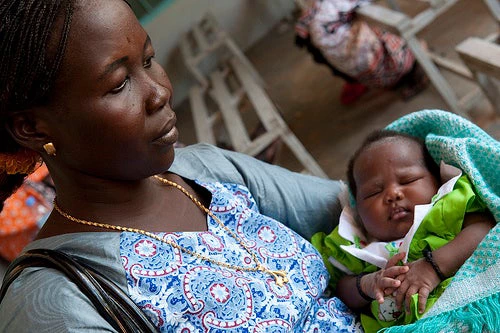
Recently I was part of a panel at an international symposium on Integrated Community Case Management (iCCM) that was held in Accra, Ghana, and hosted by UNICEF and other organizations, including the World Health Organization (WHO), U.S. Agency for International Development (USAID), Gates Foundation and Save the Children. The goal of the panel was to consider the role of partners in sustaining iCCM, in particular in supporting countries and their governments to scale up, deliver and fund iCCM.
The group agreed that iCCM helps increase access to treatment to those beyond the reach of health facilities and has the potential to more equitably address the main causes of child mortality such as pneumonia, malaria and diarrhea. iCCM also offers a way to deal effectively with other conditions such as neonatal infections, child malnutrition and neglected tropical diseases, like onchocerchiasis. In the iCCM model, community health workers (CHWs) are identified and trained in diagnosis and treatment of key illnesses and also in identifying those in need of immediate referral to health facilities and specialized personnel.
In looking forward to the post-2015 MDG period, the critical questions on everyone’s mind are: How can iCCM be scaled up in a way that ensures quality of service and increases demand? How can we assess the costs and evaluate the impact of such strategies to ensure that we are best supporting progress on child mortality and balancing needs with other pressing challenges such as malnutrition and maternal mortality?
As I noted in my comments during the Ghana panel, rather than a “vertical strategy”, iCCM should be seen as key component of an integrated health response to the multiple health needs of the population along an interconnected continuum: from health promotion, disease prevention, treatment and care, to rehabilitation.
The use of community platforms and CHWs can also be leveraged as part of intersectoral approaches to tackle the social determinants of health (e.g., poor living and working conditions, lack or limited access to basic services), behavioral and biological risk factors (e.g., smoking, alcohol abuse, high blood pressure), and cultural misconceptions about health problems that influence the risk for, or vulnerability to, both communicable and non-communicable diseases and injuries.
Integration of iCCM within broader systemic arrangements requires additional effort at the policy level. If one takes into account iCCM benchmark components (coordination and policy setting; costing and financing; human resources; supply chain management; service delivery and referral; communications and social mobilization; supervision and performance quality assurance; and monitoring, evaluation and health information systems), it is clear that institutionalization is key. That is, the scaling up and sustainability of iCCM requires that it becomes institutionalized, or fully incorporated into national priorities, policies, and programs, with corresponding funding and capacities to sustain it.
Institutionalization of iCCM also requires evidence-based frameworks to conduct a more systematic look at questions such as: How are the interventions in “health packages” selected? How often are the analyses updated? Are local data used? What are the innovative service delivery models that leverage both internal and external actors and resources that should be replicated? How are decisions reached based on evidence, and how is that evidence translated and adapted to specific institutional, cultural and fiscal realities of the countries?
So, where does iCCM fit with regard to the current and future drive to move towards universal health coverage, which the World Bank is strongly championing? The answer is simple. First, iCCM is a critical strategy to achieving equity objectives—for reaching the last 20% of people in remote regions or areas, or in refugee camps, that are hard to access due to poor roads, lack of transport and infrastructure, civil unrest or conflict.
Equally important, the institutionalization of iCCM can contribute over the medium term to sustain access to a continuum of services to poor and vulnerable population groups, particularly in rural and peri-urban areas, to offer both disease prevention interventions such as mass drug administration, alongside distribution of bed nets, micronutrients, or chemotherapy for seasonal malaria, and refer them for treatment of diseases and their co-morbidities.
Follow the World Bank health team on Twitter: @worldbankhealth
Related
World Bank and Health


Join the Conversation